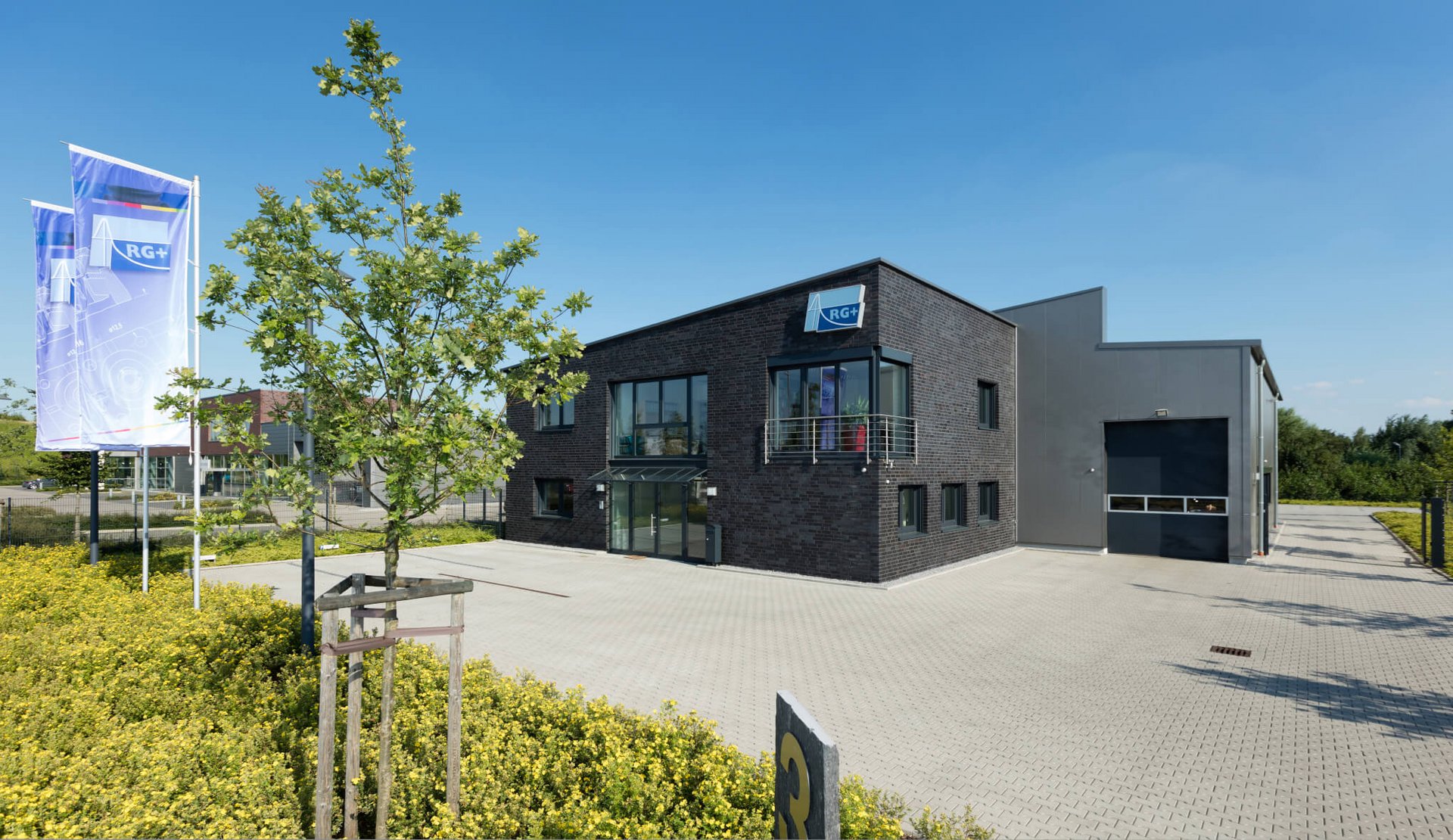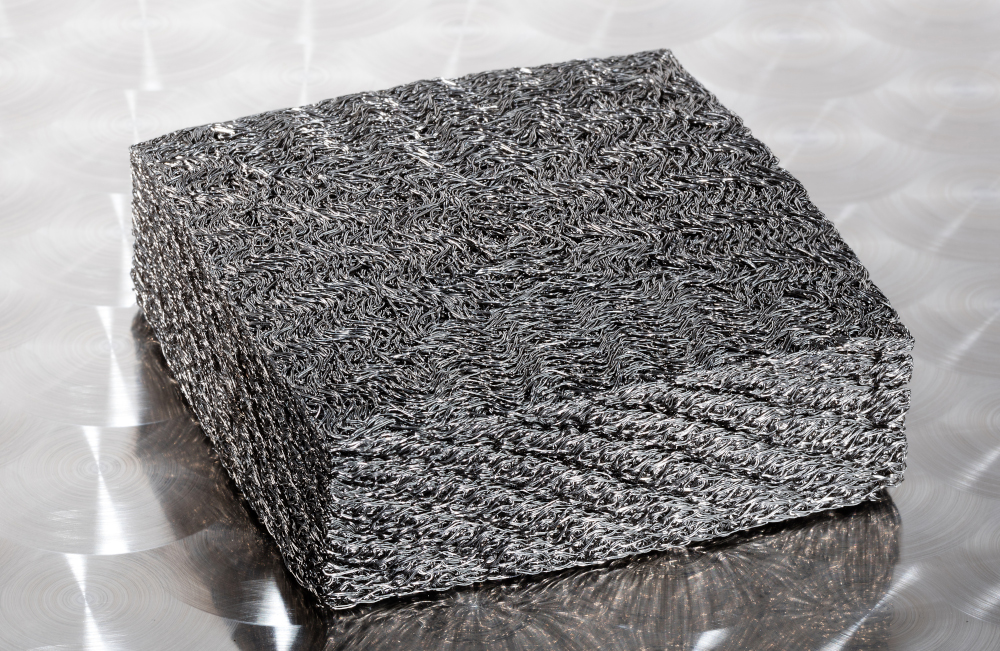Almost everyone knows vibration dampers made of elastomers. Whether in normal household use as a neoprene plate under the washing machine or as a machine base under the air conditioner in front of the house. In industry, vibration dampers are found under many applications either. Pumps are equipped with elastomer buffers. Conveyor belts have machine feet made of the same material, and CHP modules are often mounted on polyurethane-based vibration-damping mats. In use under atmospheric conditions, these types of bearings perform very well. When conditions become more challenging, rubber-based vibration dampers reach their limits. At this point, stainless steel wire meshs have their niche.
These dampers are largely unknown. At this point, the basic issues surrounding vibration dampers made of steel components will be looked at in more detail.
Manufacture in a multi-phase process, partly by hand
The main element of every vibration damper is the damping pad made of stainless steel wire. This is manufactured in a multi-stage process. First and foremost, several stainless-steel wires are knitted together to form a sock. This process is comparable to knitting in the textile industry. This stocking is then rolled to produce a mat. While these processes are still automated, the next steps are manual labor. The existing mat is pulled over a mandrel, shaped into its (usually) cylindrical form and point welded. At the end of the manufacturing process the blank is pressed to create an elastic molded part. This is used as a cushion.
But how does this technique work and what parameters are needed to design and manufacture such a cushion?
Parameters for design
An element is characterized by the same values that are used to describe the corresponding geometric shape. The outer diameter, inner diameter and height are required as a basis for a cylindrical element. For a damping element in rectangular shape the width, length and height. Other shapes can be adapted. From the respective mass of an element, the volume or density can be concluded. The weight is mandatory, because it determines how soft or hard the vibration damper will be in the end. The density of a knit wire mesh can be roughly compared to the Shore hardness of an elastomeric damper. But be careful, the force-displacement curves of these damping types differ greatly.
Forms and types of a knitted wire mesh cushion
At this point, the manufacturing process and the important parameters to design a damping cushion are known. The question, which arises involuntarily is what shapes such a stainless steel knitted cushion can take? As already mentioned above, the standard shapes are the cylinder or rectangle. These can be made both full and with a hole. Thus, they can be very well adapted to the corresponding application and the connection to it. Cushions with integrated heels are ideal for this purpose, which can be inserted into a profile by means of a simple screw with a cylindrical or hexagonal head. Recently, cushions have become increasingly common, which additionally remove radial movements from the system through their pretension. In contrast to the heel, these elements offer a central collar that can be inserted for example into a profile frame. This provides additional stability in the cushioning system and prevents the cushion from slipping. A possible rigid connection with the profile frame, which leads to vibration transmission, can thus be prevented. In this way, lateral forces can be handled to a lesser extent.
In addition to the types described, there are also cushions in special shapes, which can be manufactured with greater effort. These can, for example, be elements with different draft angles on both sides. Cushioning pads with several holes, heels or steps can also be produced.
Different material depending on temperature or environmental conditions
A great strength of knitted wire mesh is its effectiveness at temperatures above 100°C. This is related to the material from which it is made. The standard material used is 1.4301. 1.4404 is also no problem on request. If the requirements are even higher, damping elements made of 1.4841 or 2.4816 can be produced. This shows that production is possible from a wide variety of steel types, although in most cases the two standard stainless steels 1.4301 and 1.4404 are perfectly adequate.
How does a knitted wire mesh damping cushion work?
At this point you now know how a stainless-steel vibration damper is made. You also know which material is used and what is needed to dimension a damping element. The legitimate question arises, how exactly does such a wire mesh work and where are the advantages in contrast to standard elements?
The function of this damping pad is based on the internal friction of the entangled wires. During vibration-induced motion, the stainless-steel wires inside the cushion rub against each other. It is known from physics that friction generates heat. The energy introduced into the cushion is thus converted into heat and "pumped" out of the element through the existing capillary channels between the wires. At this point, it becomes apparent that the more material present in a cushion, the greater the energy adsorption. More wires in this case will create more friction. However, we do not want to go into this topic any further at this point in order not to anticipate further blog entries. Just this much in advance - the energy absorption is the reason why it can make sense in some places to stack damping elements and thus double the deflection.
Advantages of knitted wire mesh damping cushions
After all that has been written so far. Why should you use vibration dampers with an integrated stainless-steel knit when the old solutions work after all? What benefit does my customer get from this form of damping?
A first major advantage of the knitted-wire-mesh vibration damper lies in its material itself. While polymers often soften or, in the worst case, lose their dimensional stability at temperatures above 100°C, stainless steel shows no instability at higher temperatures at all. Damping pads made of 1.4301 can be used up to temperatures of 300°C without any restrictions. Above this range, even higher temperatures are possible by using 1.4404 or 1.4841. As far as dimensional stability is concerned, there is much to be said for the use of knit wire meshes. For example, they are dimensionally stable in a dynamic load range of five times the static load and return to their original shape under normal load. This means that force peaks of limited duration can be handled well. It is precisely these force peaks that can throw a system out of balance and thus cause the machine to become unintentionally skewed. A semi-parabolic force-displacement curve with a large stiffness in the high load ranges ensures that your machine stands securely and quietly. While temperature resistance was discussed above, stainless steels also offer protection against corrosion as well as bases and acids. Their compact design offers the chance to install them in the smallest possible space.
These purely technical aspects are one side of the coin. You also benefit from logistical aspects when using all-metal cushioning pads. Their long service life of up to 15 years prevents the need for annual replacement of vibration elements. This can prevent downtimes and, if necessary, even production stoppages. Experience also shows that a continuous load of up to 107 load cycles does not cause any problems for the cushion and no settling behavior can be detected. This means that a simple visual inspection on an annual basis during maintenance of your machine is sufficient to assess the functioning of the cushions.
These are certainly very many good aspects that speak for the use of this niche product. On the other hand, it should not be concealed that there are also areas where these elements are unsuitable. In the area of structure-borne sound, elements made of stainless steel do not have great insulation due to their material itself. In the working range of lower static load of the elements, the energy absorption of the elements is much lower than that of the damping elements made of polymers. Furthermore, due to the component of manual work already described at the beginning and the further production steps, the manufacturing costs for a vibration damper are higher. Equipping machines with knitted wire mesh dampers, which have only a short service life, should therefore be well considered. With long service lives, knit wire meshes pay for themselves after two to three elastomere-damper changes.
Fields of application of knitted wire mesh dampers
Now we know the knitted wire mesh and their basic properties very well. But where can I use them? What are specific applications?
The possible applications for these machine mountings are numerous. This form of vibration decoupling nearly can be used wherever its alternative is installed. The main areas of application for knitted wire mesh dampers can be found in the fields of rail transport, power engineering, plant engineering and general mechanical engineering. Here, the range is very wide, from machine tools in the workshop to transformers and tanks in rail vehicles to silencers and catalytic converters in power engineering. In these applications the advantages of metal dampers can also be recognized quickly. In almost all applications, it is essential that they are available 24 hours a day, seven days a week, or at least need to be maintained very quickly. In the field of exhaust gas aftertreatment, there are high temperatures, which pose no problems for vibration dampers made of stainless steel.
We hope that this brief outline has familiarized you a little further with our main product and look forward to supporting you with your next machine or component storage. Please feel free to contact us.
You can find this article in our downloadsection either.
Bochum, 04/08/2022


